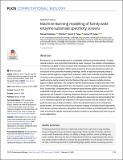| dc.contributor.author | Goldman, Samuel | |
| dc.contributor.author | Das, Ria | |
| dc.contributor.author | Yang, Kevin K | |
| dc.contributor.author | Coley, Connor Wilson | |
| dc.date.accessioned | 2022-07-12T20:43:04Z | |
| dc.date.available | 2022-03-28T19:31:43Z | |
| dc.date.available | 2022-07-12T20:43:04Z | |
| dc.date.issued | 2022-02 | |
| dc.identifier.uri | https://hdl.handle.net/1721.1/141379.2 | |
| dc.description.abstract | Biocatalysis is a promising approach to sustainably synthesize pharmaceuticals, complex natural products, and commodity chemicals at scale. However, the adoption of biocatalysis is limited by our ability to select enzymes that will catalyze their natural chemical transformation on non-natural substrates. While machine learning and <jats:italic>in silico</jats:italic> directed evolution are well-posed for this predictive modeling challenge, efforts to date have primarily aimed to increase activity against a single known substrate, rather than to identify enzymes capable of acting on new substrates of interest. To address this need, we curate 6 different high-quality enzyme family screens from the literature that each measure multiple enzymes against multiple substrates. We compare machine learning-based compound-protein interaction (CPI) modeling approaches from the literature used for predicting drug-target interactions. Surprisingly, comparing these interaction-based models against collections of independent (single task) enzyme-only or substrate-only models reveals that current CPI approaches are incapable of learning interactions between compounds and proteins in the current family level data regime. We further validate this observation by demonstrating that our no-interaction baseline can outperform CPI-based models from the literature used to guide the discovery of kinase inhibitors. Given the high performance of non-interaction based models, we introduce a new structure-based strategy for pooling residue representations across a protein sequence. Altogether, this work motivates a principled path forward in order to build and evaluate meaningful predictive models for biocatalysis and other drug discovery applications. | en_US |
| dc.language.iso | en | |
| dc.publisher | Public Library of Science (PLoS) | en_US |
| dc.relation.isversionof | 10.1371/journal.pcbi.1009853 | en_US |
| dc.rights | Creative Commons Attribution 4.0 International license | en_US |
| dc.rights.uri | https://creativecommons.org/licenses/by/4.0/ | en_US |
| dc.source | 625865 | en_US |
| dc.title | Machine learning modeling of family wide enzyme-substrate specificity screens | en_US |
| dc.type | Article | en_US |
| dc.identifier.citation | Goldman, Samuel, Das, Ria, Yang, Kevin K and Coley, Connor W. 2022. "Machine learning modeling of family wide enzyme-substrate specificity screens." PLOS Computational Biology, 18 (2). | en_US |
| dc.contributor.department | Massachusetts Institute of Technology. Computational and Systems Biology Program | en_US |
| dc.contributor.department | Massachusetts Institute of Technology. Department of Chemical Engineering | en_US |
| dc.contributor.department | Massachusetts Institute of Technology. Department of Electrical Engineering and Computer Science | en_US |
| dc.relation.journal | PLOS Computational Biology | en_US |
| dc.eprint.version | Final published version | en_US |
| dc.type.uri | http://purl.org/eprint/type/JournalArticle | en_US |
| eprint.status | http://purl.org/eprint/status/PeerReviewed | en_US |
| dc.date.updated | 2022-03-28T18:32:41Z | |
| dspace.orderedauthors | Goldman, S; Das, R; Yang, KK; Coley, CW | en_US |
| dspace.date.submission | 2022-03-28T18:32:43Z | |
| mit.journal.volume | 18 | en_US |
| mit.journal.issue | 2 | en_US |
| mit.license | PUBLISHER_CC | |
| mit.metadata.status | Publication Information Needed | en_US |
